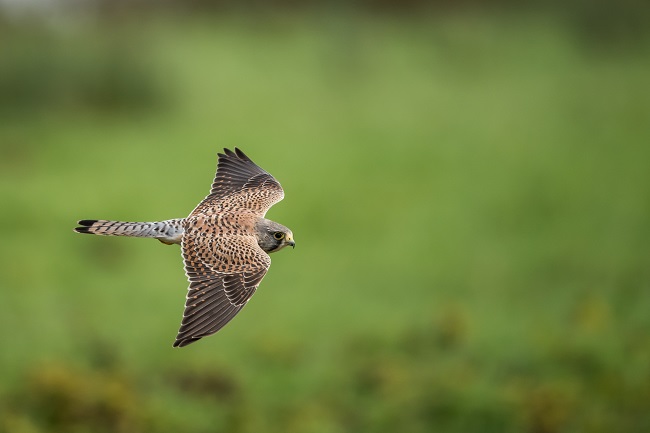
In the world of avian wonders, the kestrel stands as a symbol of resilience, grace, and adaptability. With its striking appearance and crucial role in maintaining ecological equilibrium, the kestrel is a bird that captures the imagination and underscores the delicate interplay of nature. This article explores the fascinating aspects of the kestrel’s natural habitat, average size, and its significant role in the environment.
Natural Habitat and Distribution
The kestrel, scientifically known as Falco tinnunculus, is a member of the Falconidae family. Its range spans across a vast portion of the globe, with a presence in Europe, Asia, Africa, and North America. As a highly adaptable species, the kestrel has managed to find niches in a diverse array of habitats, from grasslands and forests to urban areas and coastal cliffs.
However, the kestrel is particularly associated with open landscapes. It thrives in habitats such as meadows, savannas, and agricultural fields. These environments provide an abundant supply of its preferred diet—small mammals like voles, mice, and shrews—as well as insects. The kestrel’s ability to thrive in both natural and human-altered landscapes showcases its remarkable flexibility and ability to coexist with changing surroundings.
Average Size and Appearance
The kestrel is characterized by its compact size and vibrant plumage. On average, it measures about 9-12 inches in length, with a wingspan ranging from 20 to 24 inches. Its body is slender and streamlined, which aids in swift and agile flight. One of the kestrel’s most distinguishing features is its distinctively marked face: a pair of dark, vertical markings extending downwards from its eyes, reminiscent of sideburns, contribute to its unique appearance.
In terms of plumage, the male and female kestrels exhibit sexual dimorphism. Males are typically more colorful, boasting a slate-blue head and wings, russet back, and a cream-colored underbelly with black speckles. Females, on the other hand, have a more subdued plumage, predominantly brown with darker streaks and bars.
The Kestrel’s Role in the Environment
Beyond its striking appearance and wide distribution, the kestrel plays an indispensable role in maintaining the ecological balance of its habitat. As a top predator in its food web, the kestrel helps control populations of small mammals and insects. By preying on rodents and insects, the kestrel helps regulate their numbers, preventing potential overpopulation that could lead to detrimental effects on agricultural lands and ecosystems.
Furthermore, the kestrel’s presence serves as an indicator of the overall health of an ecosystem. A robust population of kestrels often signifies a diverse and balanced community of prey species. In this way, the kestrel acts as a natural barometer, reflecting the well-being of the environment in which it resides. In agricultural settings, the kestrel’s diet includes rodents that are considered pests by farmers. By keeping these populations in check, kestrels provide valuable pest control services that can reduce the need for chemical interventions, promoting more sustainable farming practices.
Conclusion
The kestrel stands as a testament to nature’s ability to adapt and thrive in a multitude of environments. Its presence in open landscapes and its role as a top predator highlight its significance in maintaining the ecological harmony of its surroundings. As we continue to explore the intricacies of the natural world, the kestrel serves as a reminder of the intricate relationships that bind species together and the vital role each plays in maintaining the delicate balance of our planet.
10 Fun Facts About the Kestrel
Hovering Hunters
Kestrels are known for their ability to hover in mid-air while hunting. They achieve this by flapping their wings rapidly and using their tail to maintain balance. This hovering behavior allows them to spot prey on the ground with incredible precision.
Ultraviolet Vision
Kestrels have exceptional vision, including the ability to see ultraviolet (UV) light. This unique trait enables them to detect the UV markings on the urine trails of rodents, making it easier for them to track down their prey.
Global Distribution
Kestrels are one of the most widely distributed raptor species in the world, inhabiting various regions across Europe, Asia, Africa, and North America. This widespread distribution highlights their adaptability to different environments.
Sexual Dimorphism
As mentioned earlier, male and female kestrels exhibit noticeable differences in plumage. This is known as sexual dimorphism. The distinct coloration helps each gender fulfill its specific role in reproduction and raising offspring.
Nesting Habits
Kestrels are cavity-nesting birds, which means they often seek out holes or crevices to build their nests. They have been known to use abandoned nests of other birds, as well as human-made structures like buildings and nest boxes.
High-Pitched Calls
Kestrels are quite vocal and communicate using a variety of calls. Their calls include sharp and high-pitched whistles, often used for territorial marking and communicating with mates.
Molt Migration
Some kestrels engage in a behavior known as “molt migration.” During their molting period, they may migrate shorter distances to find suitable locations where they can replace their old feathers with new ones.
Conservation Efforts
In some regions, kestrels have faced population declines due to factors such as habitat loss and pesticide exposure. Conservation efforts, including providing nest boxes and reducing the use of chemicals, have been instrumental in helping kestrel populations rebound.
Cultural Significance
Kestrels have held cultural significance in various societies throughout history. In ancient Egypt, they were associated with the sun god Ra. In medieval Europe, kestrels were used for falconry, a sport in which trained birds of prey are used to hunt.
Speed and Agility
Kestrels are renowned for their agility and speed in flight. They can reach speeds of up to 40 miles per hour when hunting, performing impressive aerial maneuvers to capture prey.
Related Articles & Free Email Newsletter Sign Up
Mysteries of the Night: Exploring the Enigmatic Great Eared Nightjar
The Eastern Phoebe Has an Eclectic Habitat and Migration Patterns


Comment here